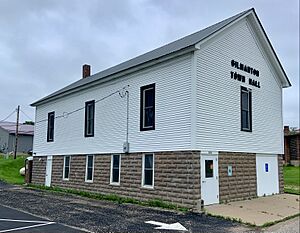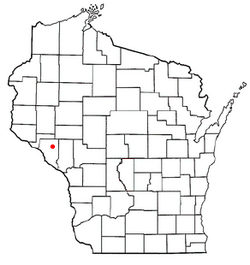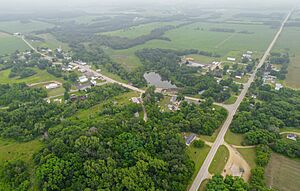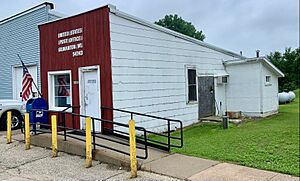Gilmanton, Wisconsin facts for kids
Quick facts for kids
Gilmanton, Wisconsin
|
|
|---|---|

Town hall
|
|
| Motto(s):
Home of Wisconsin's Biggest Little Fair!
|
|

Location of Gilmanton, Wisconsin
|
|
| Country | |
| State | |
| County | Buffalo |
| Area | |
| • Total | 36.3 sq mi (94.0 km2) |
| • Land | 35.9 sq mi (92.9 km2) |
| • Water | 0.4 sq mi (1.1 km2) |
| Elevation | 801 ft (244 m) |
| Population
(2010)
|
|
| • Total | 426 |
| • Density | 12/sq mi (4.6/km2) |
| Time zone | UTC-6 (Central (CST)) |
| • Summer (DST) | UTC-5 (CDT) |
| Area code(s) | 715 & 534 |
| FIPS code | 55-29225 |
| GNIS feature ID | 1583277 |
Gilmanton is a small town located in Buffalo County, Wisconsin, in the United States. In 2010, about 426 people lived there. The community of Gilmanton is also found within this town.
Contents
History of Gilmanton
Early Settlement in Gilmanton
Gilmanton was first settled in 1855 by a man named Samuel Gilman. He moved there with his four sons. They built cabins and cut hay to feed their animals.
Later that same year, the first baby girl was born in what was called Gilman Valley. The first religious meeting in the area was held in a settler's home. It was led by Reverend B.F. Morse.
Changing the Town's Name
In 1858, the first post office opened in Gilmanton. William Loumis was the first postmaster. Because of him, the area was first known as the "Loomis Settlement."
However, the name was officially changed to Gilmanton on May 25, 1858. This new name honored Samuel Gilman, one of the first settlers.
Geography of Gilmanton
Land and Water Area
The town of Gilmanton covers a total area of about 94.0 square kilometers (about 36.3 square miles). Most of this area is land.
About 92.9 square kilometers (35.9 square miles) is land. The rest, about 1.1 square kilometers (0.4 square miles), is water. This means a small part of the town is covered by water.
Population and People
How Many People Live Here?
In the year 2000, there were 470 people living in Gilmanton. These people lived in 173 different homes. About 126 of these homes were families.
The town had about 13 people per square mile. There were also 180 housing units, which are places where people can live.
Age Groups in Gilmanton
The people in Gilmanton are of different ages.
- About 28.5% of the population was under 18 years old.
- About 4.3% were between 18 and 24 years old.
- About 29.6% were between 25 and 44 years old.
- About 22.3% were between 45 and 64 years old.
- About 15.3% were 65 years old or older.
The average age of people in Gilmanton was 37 years.
Arts and Culture
Gilmanton Free Fair
The Gilmanton Free Fair is a special event held every year since 1947. It's a fun time for the community.
The fair has many exciting activities. These include a tractor pulling contest and a barbecue cook-off. There are also bean bag tournaments and softball games.
The fair helps raise money for local schools and other community projects. It's a great way for everyone to come together and support their town.
Notable People from Gilmanton
Many interesting people have connections to Gilmanton.
- Harold R. W. Benjamin (1893–1969) was born in Gilmanton. He was an American educator and writer. He wrote a famous book called "The Saber-Tooth Curriculum."
- Charles W. Gilman (1862–1938) was born in the town. He was a lawyer and served as a Wisconsin State Representative, helping to make laws for Wisconsin.
- Franklin Gilman (1825–1880) lived in Gilmanton. He was a farmer and also served as a Wisconsin State Representative.
- Elmer A. Kenyon (1870–1922) was born here. He was a farmer, businessman, and a Wisconsin State Representative.
- Edward Lees (around 1819–1893) was a politician who lived in the town.
- Edwin J. Peterson (born 1930) was born and lived in Gilmanton. He became the Chief Justice of the Oregon Supreme Court, which is a very important judge.
See also
 In Spanish: Gilmanton (Wisconsin) para niños
In Spanish: Gilmanton (Wisconsin) para niños



